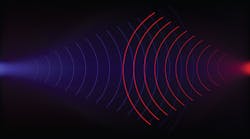A high-frequency radar technique developed by researchers in Sweden measures what is happening inside fluidized beds with what they describe as “unrivaled” precision.
Their high-frequency pulse-Doppler radar technique operates at up to 340 GHz, giving high spatial and temporal resolutions, allowing the determination of even minimal changes to both solids velocity and concentration in real time with good penetration.
Based at Chalmers University of Technology in Gothenburg, the researchers demonstrated their technology on a 3.1-m-high circulating fluidized bed boiler, with 0.45m2 cross-sectional area, using glass beads with a mean particle size of 106 µm, and particle density of 2,486 kg/m3. Air at ambient temperature was used as the fluidization agent (Figure 1).
According to Marlene Bonmann, a researcher in Chalmers’ terahertz and millimeter wave laboratory, the plan now is to expand the range of solids concentrations that can be characterized while keeping or even increasing the current radar penetration distance.
She notes that either increasing the output power of the radar or working at lower frequencies can increase penetration but at the cost of reduced signal backscattering, which makes it harder to detect low solids concentration.
“The intended application will decide which frequency band is best to use. We are currently working on the development of a lower-frequency radar. Up to which levels of solids concentration the assumption of signal scattering will work will be tested experimentally. Deeper understanding of these possible effects will probably require some simulation work,” Bonmann explained.
The researchers are also experimenting with the angle of incidence of the radar beam where it penetrates the process chamber to minimize the influence of static reflections.
“The radar beam can be narrowed by using a larger antenna/mirror. This will allow even more local measurements. We envision such improvement further ahead in time linked to the study of larger fluidized bed units,” added Bonmann.
Meanwhile, the data gathered with the radar technique is already being used to study backmixing of solids in circulating beds.
“The richness of the data allows for quite a detailed characterization of the solids movement. We work currently with the analysis of data and the design of experiments that target specific phenomena and specific sections of the fluidized bed reactors. Additionally, industry is showing some interest to use the radar for the measurement of solids fluxes and monitoring the agglomeration processes in full-scale combustion plants,” Bonmann concluded.


